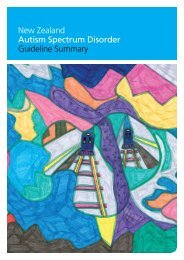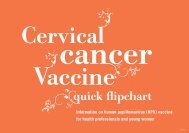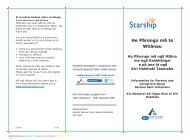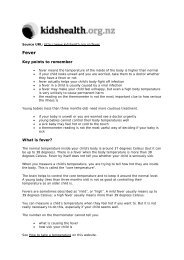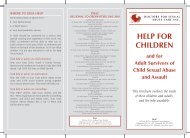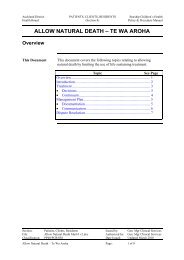New Zealand Autism Spectrum Disorder Guideline - Ministry of Health
New Zealand Autism Spectrum Disorder Guideline - Ministry of Health
New Zealand Autism Spectrum Disorder Guideline - Ministry of Health
You also want an ePaper? Increase the reach of your titles
YUMPU automatically turns print PDFs into web optimized ePapers that Google loves.
Glossary<br />
Facilitated<br />
communication (FC)<br />
False memory<br />
Family-centred services<br />
Family Care Plan (FCP)<br />
Floor Time<br />
Formulation<br />
Fragile X<br />
Functional alternative<br />
Functional analysis<br />
technique used for people with communication difficulties whereby they are<br />
supported to point to or touch objects, letters, symbols or pictures<br />
memory <strong>of</strong> an event that did not happen or is a distortion <strong>of</strong> an event that<br />
did occur as determined by externally corroborated facts<br />
services, goals and plans for a child that are based on family needs and<br />
preferences<br />
a support plan to meet the individual needs <strong>of</strong> children and their families,<br />
usually around early intervention services<br />
therapy provided by the Floortime Foundation, which describes it as<br />
meeting a child at his current developmental level and building on his/her<br />
particular set <strong>of</strong> strengths<br />
the process <strong>of</strong> integrating assessment information systematically<br />
a single gene disorder causing intellectual disability, and autistic and<br />
hyperactive behaviour in males. Females usually have more subtle learning<br />
difficulties and <strong>of</strong>ten have problems with social anxiety.<br />
a behaviour that serves the same function as a current challenging<br />
behaviour. Teaching functional alternative behaviours helps to eliminate the<br />
undesirable behaviour by reducing the need for it.<br />
determining the possible cause <strong>of</strong> inappropriate behaviour, through a<br />
process <strong>of</strong> observation, data collection and the systematic manipulation <strong>of</strong><br />
variables. Used to identify intervention strategies.<br />
Functional analysis is based on the notion that all behaviour serves<br />
a function for the individual concerned. If the function <strong>of</strong> a specific<br />
undesirable behaviour is known, then an appropriate functional alternative<br />
can be taught, and undesirable behaviour eliminated by ensuring that it<br />
functions as well as the appropriate alternative.<br />
Functional assessment<br />
the observation phase <strong>of</strong> functional analysis. Sometimes referred to as<br />
‘functional behaviour assessment’.<br />
Functional<br />
communication<br />
Functional<br />
communication training<br />
how the child communicates in their everyday environments which may<br />
include a range <strong>of</strong> communication forms, eg, signs, gestures, visual symbols<br />
or language<br />
is <strong>of</strong>ten part <strong>of</strong> an intervention where a problem behaviour serves a<br />
communicative function. Acceptable functional alternatives to the problem<br />
behaviour are taught so that the child is able to communicate appropriately.<br />
Glossary<br />
Functionality<br />
Further education<br />
Generalisation<br />
likely to be useful – giving access to control <strong>of</strong> the child or young person’s<br />
environment, increasing independence and quality <strong>of</strong> life, increasing<br />
competence <strong>of</strong> performance<br />
tertiary education (university or polytechnic), adult education, and<br />
vocational training schemes<br />
transfer <strong>of</strong> learning. When behaviour learned in a certain setting or in the<br />
presence <strong>of</strong> a certain stimulus occurs in other similar settings or in the<br />
presence <strong>of</strong> other similar stimuli. Also known as ‘stimulus generalisation’.<br />
<strong>New</strong> <strong>Zealand</strong> <strong>Autism</strong> <strong>Spectrum</strong> <strong>Disorder</strong> <strong>Guideline</strong> 249



